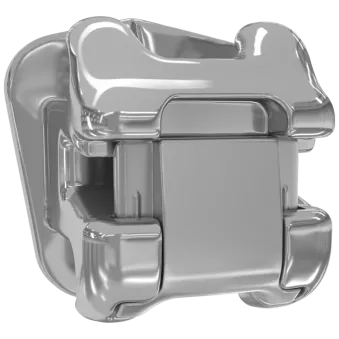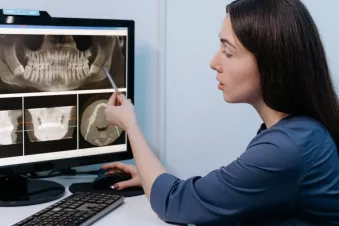
Understanding The Differences Between Clear Braces vs Aligners
Some Questions to Ask When Starting Orthodontic Treatment
So, you have made the decision to seek orthodontic care! That is great, but you have some concerns, don’t you? You have scoured the internet for reviews and asked your friends for input on their own experiences. Are you going to rely on mail order care for that smile of a lifetime? Didn’t think so. Now it is time for that orthodontic consultation by someone that extended their education two or three years beyond dental school to become the expert and that is who you should seek out to care for you. The orthodontist and their staff are best trained to guide your decisions. During new patient initial orthodontic consultations, it is common that orthodontists are asked the questions:
- What is the difference between braces and aligners that would affect my treatment?
- What option would be best for my teeth?
- What are the differences in cost?
After over 30 years of providing care using all types of appliances, in our office and probably all orthodontic offices, we are recognizing that both clear braces and aligner options for care have prompted curious patients to seek out more information. Likely more adults, but also teens, want to explore orthodontic care with the clear options foremost in their decision to seek care.
Evaluating Your Treatment Options with Braces
For all orthodontic treatments, the orthodontist examines your teeth and bite, and reviews x-rays to determine that healthy bone, jaws, and teeth are present. After evaluating your treatment needs and diagnosing the problems present, the orthodontist then discusses the best manner for your individual treatment. These steps, completed by the trained professional most capable of providing your care, are critical to the success of the treatment results you desire. While direct mail aligners are becoming increasingly popular, that option may have a significant challenge for optimal treatment diagnosis and treatment planning. In addition, with direct mail aligners there may be no individual discussions with a trained orthodontist to determine your best course of care. As a result, no one would be there to address your expectations or monitor your care, another critical aspect of success! While it is likely mail order treatment costs less monetarily, but what about the cost to your oral health if treatment not directed by and monitored by a trained professional goes awry?
There have been many advancements in orthodontic appliances. Metal braces are smaller and with new wire advancements, how the brackets and wires work toward efficiency in care has decreased treatment times. Metal braces and wires still carry the stigma of “metal mouth” but the appearance is much improved. Clear braces are not new but advancements in materials and manufacturing have improved the appliances. Concerns of staining are minimized, how the wires worked with the braces and frictional binding may have slowed treatment in the past, and removal was a concern for potential tooth surface damage.
Our office has used Ormco company’s Damon™ System of self-ligating brackets for both metal and clear braces with excellent results. Unlike traditional brackets that use elastics to tie down the wire, the Damon System uses a small door to hold the wire within the bracket. This will result in less binding, less friction, and lower pressures to the teeth for patient comfort and improved treatment efficiency. The Damon System of braces and wires help to develop the broad, full smile that many patients desire. The Damon System comes in a clear option, which provides better aesthetics so that people do not realize you are wearing braces. Unlike other clear braces with visible metal parts or elastic ties that can yellow during treatment, Damon Clear braces are resistant to staining and do not use elastic ties. Once you have decided which treatment option is best for you in consultation with your orthodontist some orthodontic office schedules allow for “same day starting” for braces, getting you well on your way for the smile and bite you desire the same day you have your consultation.
Evaluating Your Treatment Options with Aligners
Currently, similar technological and material advancements can be stated about clear aligners as much has been learned since their inception to orthodontics in 1999. Our office has used the leading aligner brand since inception, on selected cases when first introduced, but on increasingly more cases as improvements were made. Having used the Ormco family of products since I graduated from the University of North Carolina Orthodontic program, I was fortunate to be a clinical tester for the company’s new Spark™ Clear Aligner System. We have found Spark to perform optimally in all facets of treatment and is now our clear aligner of choice.
A major difference for clear aligners as compared to traditional braces is the “up front” work required by the orthodontic office doctor and staff prior to initiation of care. The necessary impressions or computer scans of the teeth as well as patient photos and x-rays are sent along with the unique prescription for you, the patient, to the aligner company. A lab technician at the aligner company then develops a tooth movement and alignment plan for your doctor. Your doctor will then review the plan and provide feedback to optimize your treatment. Once these changes are made and after the final approval, all the aligners are produced by the aligner manufacturer and shipped to the orthodontic office. This could take three to six weeks before you can start your journey to align your teeth! While some offices may give you a clear aligner the same day you have your consultation, it would be to get you comfortable wearing an aligner and would not apply much or any true movement forces to your teeth.
In most cases, small, tooth colored specially engineered “attachments” may be placed on the teeth to help promote certain tooth movements to occur or for anchorage to some teeth to help others move more efficiently. The clear aligners then fit over the attachments providing the necessary tooth movement forces necessary to achieve alignment. Typically, the patient will be given multiple aligners on delivery day and change aligners on a weekly basis. Each aligner is engineered to provide a small amount of linear or rotational movement, thus requiring changing and advancing aligners to achieve the planned result. Like braces being attached all the time and the wires actively working continuously, clear aligners need to be worn basically full time except to eat or clean your teeth for optimal movements to occur. Most treatment plans require a refinement designed to improve the current progress or optimize the finish. For a refinement, new impressions or scans are sent to the aligner company to make another set of trays.
Determining the Right Treatment Option for You
After learning the differences in orthodontic appliances, and knowing your preference for a clear treatment option you then need to determine if you prefer clear braces attached to your teeth all the time or removable clear aligners. While aligners are great options, some patients know they may not be reliable wearing removable aligners or that aligners may not fit into their lifestyle. In addition, your orthodontist may feel more comfortable with some malocclusion (bad bite) corrections using braces as opposed to clear aligners. Clear aligners may not provide the broad smile achievable with the Damon Clear braces. However, there are also some bites where clear aligners are the best option to use for treatment, particularly open bites where the teeth do not touch in the anterior (front teeth). Also, in some unique scenarios, a combination of braces and aligner treatment may be a consideration. Typically, that would involve upper tooth clear aligners and lower braces where the lower teeth are often more significantly misaligned and treatment with aligners only may not be as efficient or could take longer to finish care. Again, only a trained specialist is best capable of guiding your decision.
The Difference in Cost Between Braces and Aligners
One of my good orthodontist friends and classmates always talked about getting to the bottom line. What about the costs of braces vs aligners? Obviously, there are regional differences with orthodontic costs. Patients will find the cost of care typically varies when considering metal versus clear braces or clear aligners. Metal braces may be less expensive than clear braces or clear aligners. Some orthodontic practices may have a 10 percent or higher increase in fees when using clear treatment options.
Our office philosophy is to eliminate cost as a barrier to care by offering any option at the same cost to the patient. We prefer to inform the patient of their needs, give our influential information on how we can best manage their care efficiently, and let them make the decision on the type of appliance (treatment option) they believe they would prefer. Many offices offer payment plans to help the patient afford care. Bottom line? braces, either clear or metal, put more control over the treatment process and result with the orthodontist…with of course, cooperation by the patient. Clear aligners have most of the planning “up front” and require the patient perhaps to be more diligent in following a plan prescribed at the beginning to achieve the result. That is just one reason we prefer the Damon Clear Braces as an option to give the orthodontist more control and to achieve optimal results on difficult cases. Creating a beautiful, healthy smile is a mutual goal and many tools are available for the orthodontist to achieve the patient’s desire for the smile of their life.
About Dr. Mike Mayhew—Boone, NC, USA
Mike Mayhew, DDS, MS, received his dental education at the University of North Carolina with specialty degrees in pediatric dentistry and orthodontics. He is board certified in both specialties and operates a dual-specialty practice in Boone and North Wilkesboro, North Carolina. He is on the Sports Medicine Team at Appalachian State University, is an adjunctive clinical professor at the UNC School of Dentistry, has held leadership positions in organized dentistry, and serves as the director of the North Carolina/South Carolina Damon Study Club. He was inducted into the American College of Dentists in 2010 and the International College of Dentists in 2013.


